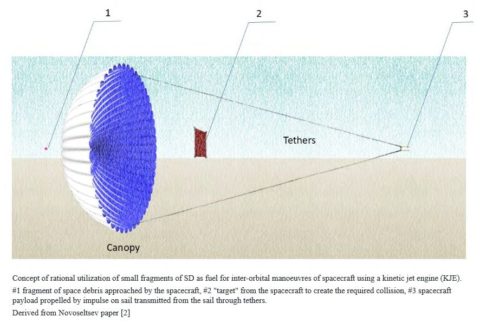Project description
It is proposed the development of engines for single-pulse interorbital maneuvers of ultra-small spacecrafts (Femto - class). It is assumed that the technology and design elements of kinetic jet engines (KJEs) will be used. It is planned to develop the possibility of cost-effective using of small fragments of space debris and waste of technological processes in engines. The technologies are aimed at a wide sector of developers and users of ultra-small Femto-class spacecraft (gramm-scale), including legal entities and individuals (B2B and B2C), research and educational organizations, and independent researchers. One of the technologies being developed will reduce the mass and cost of individual femtosatellites by an order of magnitude relative to the ChipSat format.
Issue addressed by the project
Mastering the design and production of the lower part of the line of ultra-small spacecraft [1] with a unit mass of 100 g or less – Pico - and Femto-classes, including non-hull spacecrafts "on board" (StarChip) [2], with the cost of manufacturing the SC and its launch proportional to its mass, opens up opportunities for significantly more cost-effective solutions to most problems of space research, development and use than the use of traditional means, and prospects for solving new problems. The extremely low cost of such ultra-small SCs (from several thousand rubles for a single spacecraft and from several tens of thousands of rubles, or from tens to hundreds of us dollars) opens the possibility of participation in space activities of new participants with a limited budget-legal entities and individuals. The main problem that limits the scope of application of ultra-small SCs is the lack of propulsion systems that allow them to perform independent maneuvers. Currently, a batch launch of modern such spacecrafts in the amount of 100-200 is being carried out in a CubeSat 3U launch container [2], the mass of which can exceed the mass of the entire group of femtosatellites, and data collection and transmission of such spacecraft after being withdrawn from the container is carried out from a small area near the container. Miniaturization of traditional gas-dynamic rocket engines, including chemical, thermocatalytic and cold-gas engines, and their auxiliary systems for installation on such ultra-small SCs is impossible for a number of reasons (including locking the flow part with boundary layers), while in general, the characteristics of gas-dynamic engines are significantly reduced when the size is reduced [3 ]. Currently, electrodynamic propulsion systems using the Lorentz force are proposed for femtosatellites [4, etc.] and solar sails integrated into the structure of the femtosatellite [5, etc.]. they belong to the engines of constant micro-thrust to maintain a constant height of the femtosatellite in low earth orbit. R&D is underway to create a family of electro-reactive (ion) micro-thrust engines for nanosatellites that are fundamentally scalable for ultra-small SCs [6]. Their capabilities are limited by the extremely low power of solar panels of femtosatellites and the lack of other onboard energy sources. These engines are also referred to as micro-thrust engines. Known technical solutions do not allow performing maneuvers of ultra-small SCs with a significant change in speed for a short period of time. The exception is research in the framework of the Breakthrough Starshot project of the Breakthrough Initiatives Foundation [7]. It involves the use of a high-thrust engine for the StarChip spacecrafts, as a combination of a relatively large light sail and a stationary laser installation of constant ultra-high power (up to 50-100 GW). Implementation of the project requires solving a significant number of scientific and technical, and financial and economic problems. The term of its technical implementation is tentatively estimated by the organizers at 20 years, and the cost is $ 5-10 billion. (incl. the initial stage of research - $ 100 million for 5-10 years). The proposed project involves the creation in the nearest future of a family (https://cloud.mail.ru/public/4wW4/2cDs4Thtd) low-cost engines of ultra-small SCs of simple and technological design - both micro-thrust and relatively large (in comparison with the mass of the spacecraft) thrust, allowing the SCs to fly to higher orbits and further into deep space in a minimum time. The maximum economic and associated techno-ecological effect can be achieved by using fragments of space debris (including previously completed spacecraft of this class) as an energy source. In the future, debris from the ISS or other orbital structures can also be used as an energy source, and then waste from processing space matter during the extraction of mineral resources, and lasers. 1. Andreas M. Hein, Zachary Burkhardt, T. Marshall Eubanks "AttoSats: ChipSats, other Gram-Scale Spacecraft, and Beyond" https://arxiv.org/abs/1910.12559. 2. Zachary Manchester, Mason Peck, Andrew Filo, “KickSat: A Crowd-Funded Mission To Demonstrate The World’s Smallest Spacecraft” , Proceedings of the 27th AIAA/USU Conference, Small Satellite Constellations, Logan, Utah, USA, Aug. 10-15, 2013, paper: SSC13-IX-5. 3. Якутин А. В. Исследование рабочих процессов в микродвигательных установках// Электр. журн. Тр. МАИ. 2011. Вып. 45. 4. T. R. Perez and K. Subbarao, “A Survey of Current Femtosatellite Designs, Technologies, and Mission Concepts”, Journal of Small Satellites, vol. 5, no. 3, pp. 467–482, 2016 https://jossonline.com/page_id1891. 5. J. Atchison and M. Peck, “A passive, sunpointing, millimeter-scale solar sail”, Acta Astronautica, vol. 67, no. 1, pp. 108–121, 2010 https://cloud.mail.ru/public/24RM/5wraVMAmM. 6. https://www.accion-systems.com/our-technology?fbclid=IwAR0eYVPul_3GfczIUYvPqVIqET9R7oLASYe_WBNEj2i1B4pcBI_G4YigaJI. 7. https://breakthroughinitiatives.org/research/3?fbclid=IwAR3c-zK9p6jWI2E7vfsqaha8_fne1TV2zXXSI3JY1ezafOpy0WyNc1GJv58. 8. Smallsats by the Numbers 2020 http://www.brycetech.com/downloads/Bryce_Smallsats_2020.pdf
Solution(s) brought by the project
- Contacts with customers and ecosystem partners - developers and users of Femto-spacecrafts.
- Attracting investment in the project and project funding.
Project need(s)
- Looking for customers and ecosystem partners - developers and users of Femto-spacecrafts.
- Looking for investment in the project.
More information
Video

